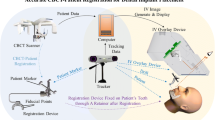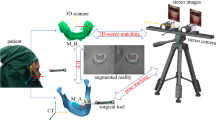Abstract
Augmented reality surgery has not been successfully implemented in dental implant surgery due to the negative impact of an incorrect implant placement. This research aimed to improve the convergence between computed tomography derived teeth model and real-time stereo view of patient’s teeth to provide high registration accuracy. Enhanced iterative closest point algorithm is proposed to reduce the error caused due to matching wrong points. Weighting mechanism and median value are used to reduce alignment error caused due to matching wrong points. In addition, random sample consensus (RANSAC) algorithm is used to detect and remove the outlier. Furthermore, the current solution for dental implants did not provide the position and orientation of the surgical tool, and without this information, there is a risk of damaging adjacent structure, dental nerves, and root canals. Optical tracking device is used in the proposed solution to address this information and ensure that nerve does not get damaged during the dental implant placement surgery. While the state-of-the-art solution provided 0.44 mm registration accuracy, the proposed solution was improving it by providing 0.33 mm registration accuracy. Additionally, the proposed system can produce good results despite not having a good initialization. The processing time improved to 14 fps in comparison to the 9-fps given by state-of-the-art solution. The proposed system improved the accuracy of convergence and the processing time compared to the globally optimal-ICP algorithm. We also employed RANSAC algorithm to detect and remove the outlier on the estimation and reduce the influence of extreme points.







Similar content being viewed by others
Abbreviations
- ICP:
-
Iterative closest point
- Go-ICP:
-
Globally optimal iterative closest point
- RANSAC:
-
Random sampling consensus
- CT:
-
Computed tomography
- AR:
-
Augmented reality
- EICP:
-
Enhanced iterative closest point
- RMaTV:
-
Rotation matrix and translation vector
- TLD:
-
Tracking learning detection
- PCA:
-
Principle component analysis
- CPD:
-
Coherent point drift
- SVD:
-
Singular value decomposition
- VST-AR:
-
Video see-through augmented reality
- MKLMN:
-
Modified kernel non-local
References
Wang J et al (2013) Real-time marker-free patient registration and image-based navigation using stereovision for dental surgery. In: Liao H, Linte CA, Masamune K, Peters TM, Zheng G (eds) Augmented reality environments for medical imaging and computer-assisted interventions. Springer, Berlin, pp 9–18
Ma L et al (2019) Augmented reality surgical navigation with accurate CBCT-patient registration for dental implant placement. Med Biol Eng Compu 57(1):47–57. https://doi.org/10.1007/s11517-018-1861-9
Basnet BR, Alsadoon A, Withana C, Deva A, Paul M (2018) A novel noise filtered and occlusion removal: navigational accuracy in augmented reality-based constructive jaw surgery. Oral Maxillofac Surg 22(4):385–401. https://doi.org/10.1007/s10006-018-0719-5
Weipeng J et al (2018) Evaluation of the 3D augmented reality–guided intraoperative positioning of dental implants in edentulous mandibular models. Int J Oral Maxillofac Implants 33(6):1219–1228. https://doi.org/10.11607/jomi.6638
Wang J, Suenaga H, Yang L, Kobayashi E, Sakuma I (2017) Video see-through augmented reality for oral and maxillofacial surgery. Int J Med Robot Comput Assis Surg 13(2):e1754. https://doi.org/10.1002/rcs.1754
Wang J, Shen Y, Yang S (2019) A practical marker-less image registration method for augmented reality oral and maxillofacial surgery (in English). Int J Comput Assist Radiol Surg 14(5):763–773. https://doi.org/10.1007/s11548-019-01921-5
Nakao M, Endo S, Nakao S, Yoshida M, Matsuda T (2016) Augmented endoscopic images overlaying shape changes in bone cutting procedures (in English). PLoS ONE 11(9):e0161815. https://doi.org/10.1371/journal.pone.0161815
Chen X, Xu L, Wang H, Wang F, Wang Q, Kikinis R (2017) Development of a surgical navigation system based on 3D Slicer for intraoperative implant placement surgery. Med Eng Phys 41:81–89. https://doi.org/10.1016/j.medengphy.2017.01.005
Kalal Z, Mikolajczyk K, Matas J (2012) Tracking-learning-detection. IEEE Trans Pattern Anal Mach Intell 34(7):1409–1422. https://doi.org/10.1109/TPAMI.2011.239
Ulrich M, Wiedemann C, Steger C (2012) Combining scale-space and similarity-based aspect graphs for fast 3D object recognition. IEEE Trans Pattern Anal Mach Intell 34(10):1902–1914. https://doi.org/10.1109/TPAMI.2011.266
Murugesan YP, Alsadoon A, Manoranjan P, Prasad PWC (2018) A novel rotational matrix and translation vector algorithm: geometric accuracy for augmented reality in oral and maxillofacial surgeries. Int J Med Robot Comput Assist Surg 14(3):e1889. https://doi.org/10.1002/rcs.1889
Pokhrel S, Alsadoon A, Prasad PWC, Paul M (2019) A novel augmented reality (AR) scheme for knee replacement surgery by considering cutting error accuracy. Int J Med Robot Comput Assist Surg 15(1):e1958. https://doi.org/10.1002/rcs.1958
Ma L, Zhao Z, Chen F, Zhang B, Fu L, Liao H (2017) Augmented reality surgical navigation with ultrasound-assisted registration for pedicle screw placement: a pilot study. Int J Comput Assist Radiol Surg 12(12):2205–2215. https://doi.org/10.1007/s11548-017-1652-z
Thompson S et al (2016) Hand-eye calibration for rigid laparoscopes using an invariant point (in English). Int J Comput Assist Radiol Surg 11(6):1071–1080. https://doi.org/10.1007/s11548-016-1364-9
Yamaguchi S, Ohtani T, Yatani H, Sohmura T (2009) Augmented reality system for dental implant surgery. In: Virtual and mixed reality. Springer, Berlin, pp 633–638
Collins JA et al (2017) Improving registration robustness for image-guided liver surgery in a novel human-to-phantom data framework. IEEE Trans Med Imaging 36(7):1502–1510. https://doi.org/10.1109/TMI.2017.2668842
Totz J et al (2014) Fast semi-dense surface reconstruction from stereoscopic video in laparoscopic surgery. In: Cham A, Stoyanov D, Collins DL, Sakuma I, Abolmaesumi P, Jannin P (eds) Information processing in computer-assisted interventions. Springer, Berlin, pp 206–215
Thompson S et al (2018) In vivo estimation of target registration errors during augmented reality laparoscopic surgery. Int J Comput Assist Radiol Surg 13(6):865–874. https://doi.org/10.1007/s11548-018-1761-3
Wang J, Shen Y, Yang S (2019) A practical marker-less image registration method for augmented reality oral and maxillofacial surgery. Int J Comput Assist Radiol Surg 14(5):763–773. https://doi.org/10.1007/s11548-019-01921-5
Wang J et al (2015) 3D surgical overlay with markerless image registration using a single camera. In: Cham, 2015: Springer International Publishing, in Augmented Environments for Computer-Assisted Interventions, pp 124–133
Yang J, Li H, Campbell D, Jia Y (2016) Go-ICP: a globally optimal solution to 3D ICP point-set registration. IEEE Trans Pattern Anal Mach Intell 38(11):2241–2254. https://doi.org/10.1109/TPAMI.2015.2513405
Ma Q et al (2019) Development and preliminary evaluation of an autonomous surgical system for oral and maxillofacial surgery. Int J Med Robot Comput Assist Surg 15(4):e1997. https://doi.org/10.1002/rcs.1997.33933
Wang J et al (2015) Real-time computer-generated integral imaging and 3D image calibration for augmented reality surgical navigation (in English). Comput Med Imaging Graph 40:147–159. https://doi.org/10.1016/j.compmedimag.2014.11.003
Zhang X et al (2019) A markerless automatic deformable registration framework for augmented reality navigation of laparoscopy partial nephrectomy. Int J Comput Assist Radiol Surg 14(8):1285–1294. https://doi.org/10.1007/s11548-019-01974-6
Rucker DC et al (2014) A mechanics-based nonrigid registration method for liver surgery using sparse intraoperative data (in English). IEEE Trans Med Imaging 33(1):147–158. https://doi.org/10.1109/tmi.2013.2283016
Thompson S et al (2015) Accuracy validation of an image guided laparoscopy system for liver resection (SPIE medical imaging). In: SPIE
De Paolis LT, De Luca V (2019) Augmented visualization with depth perception cues to improve the surgeon’s performance in minimally invasive surgery. Med Biol Eng Compu 57(5):995–1013. https://doi.org/10.1007/s11517-018-1929-6
Lin Q et al (2019) Geometric calibration of markerless optical surgical navigation system. Int J Med Robot Comput Assist Surg 15(2):e1978. https://doi.org/10.1002/rcs.1978
Zhang Z (2000) A flexible new technique for camera calibration. IEEE Trans Pattern Anal Mach Intell 22(11):1330–1334. https://doi.org/10.1109/34.888718
Wold S, Esbensen K, Geladi P (1987) Principal component analysis. Chemometr Intell Lab Syst 2(1):37–52. https://doi.org/10.1016/0169-7439(87)80084-9
Wu ML, Chien JC, Wu CT, Lee JD (2018) An augmented reality system using improved-iterative closest point algorithm for on-patient medical image visualization (in English). Sensors (Basel). https://doi.org/10.3390/s18082505
Ahn J, Choi H, Hong J, Hong J (2019) Tracking accuracy of a stereo camera-based augmented reality navigation system for orthognathic surgery. J Oral Maxillofac Surg 77:1070
Gao QH, Wan TR, Tang W, Chen L (2019) Object registration in semi-cluttered and partial-occluded. Multimed Tools Appl 78(11):15079–15099
Liu J, Al’Aref SJ, Singh G, Caprio A, Moghadam AAA, Jang SJ, Wong SC, Min JK, Dunham S, Mosadegh B (2019) An augmented reality system for image guidance of transcatheter procedures for structural heart disease. PLoS ONE 14(7):e0219174. https://doi.org/10.1371/journal.pone.0219174
Pepe A, Trotta GF, Mohr-Ziak P, Gsaxner C, Wallner J, Bevilacqua V, Egger J (2019) A marker-less registration approach for mixed reality–aided maxillofacial surgery: a pilot evaluation. J Digit Imaging 32:1–11
Carl B, Bopp M, Saß B, Pojskic M, Nimsky C (2019) Augmented reality in intradural spinal tumor surgery. Eur Spine J 161(10):2181–2193
Author information
Authors and Affiliations
Corresponding author
Additional information
Publisher's Note
Springer Nature remains neutral with regard to jurisdictional claims in published maps and institutional affiliations.
Rights and permissions
About this article
Cite this article
Shrestha, L., Alsadoon, A., Prasad, P.W.C. et al. Augmented reality for dental implant surgery: enhanced ICP. J Supercomput 77, 1152–1176 (2021). https://doi.org/10.1007/s11227-020-03322-x
Published:
Issue Date:
DOI: https://doi.org/10.1007/s11227-020-03322-x




